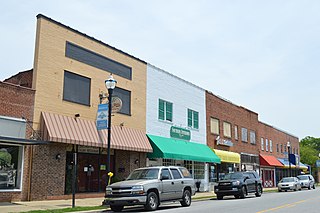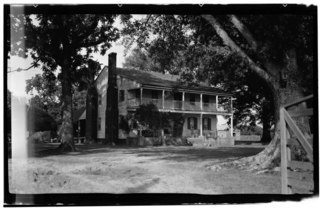
The La Grange Historic District is a national historic district located in La Grange, North Carolina, United States. The district, originally encompassing 225 buildings and 1 structure, includes the historic commercial, residential, and industrial center of La Grange. The buildings include notable examples of Gothic Revival, Queen Anne and Bungalow/American Craftsman styles of architecture and date between the 1850s and the 1940s. Located in the district is the separately listed La Grange Presbyterian Church. Other notable buildings include the Sutton-Kinsey House, Walter Pace House, Sutton-Fields House, Colonel A. C. Davis House (1887), and the Rouse Banking Company Building (1908). The historic district was added to the National Register of Historic Places in May 2000.
Upper Town Creek Rural Historic District is a national historic district located near Wilson, in Edgecombe and Wilson County, North Carolina. The district encompasses 117 contributing buildings and 2 contributing structures on four contiguous farms near Wilson. The main plantation house on each farm are the Federal-style W. D. Petway House ; the Greek Revival house built for Colonel David Williams ; the house built for Cally S. Braswell ; and the board and batten Gothic Revival Jesse Norris House. The remaining contributing building and structures include packhouses, tobacco barns, tenant houses, and other agricultural outbuildings.

Belmont Historic District is a national historic district located at Belmont, Gaston County, North Carolina. It encompasses 264 contributing buildings, 1 contributing site, and 2 contributing structures in the central business district and adjacent residential areas of Belmont. The district was developed after 1873, and includes notable examples of Colonial Revival, Tudor Revival, and Bungalow / American Craftsman architecture. Located in the district is the separately listed U.S. Post Office, Former. Other notable buildings include the R.L. Stowe Mills Office Building, Bank of Belmont (1926), Piedmont and Northern Railroad Depot, Belmont Hotel, Abel C. Lineberger House No. 2 designed by Charles Christian Hook (1870–1938), Samuel Pinckney Stowe House, James W. Stowe House, Sacred Heart College, and Belmont High School (1939).

Scotland Neck Historic District is a national historic district located at Scotland Neck, Halifax County, North Carolina. It encompasses 249 contributing buildings and 1 contributing object in the central business district and surrounding residential sections of the town of Scotland Neck. The district includes notable examples of Greek Revival and Gothic Revival style architecture. Located in the district is the separately listed Hoffman-Bowers-Josey-Riddick House. Other notable buildings include the Fenner-Shields-Lamb House (1827); D. Edmondson Building, E. T. Whitehead drug store ; Scotland Neck Bank (1914); Baptist Church (1917); Trinity Episcopal Church (1924); and town hall and fire station (1939), brick gymnasium and vocational building (1940), and one-story, elongated brick multiple housing unit (1943) built by the Works Progress Administration. The latter building was utilized as a prisoner-of-war camp during World War II.

Ahoskie Downtown Historic District is a national historic district located at Ahoskie, Hertford County, North Carolina. The district encompasses 14 contributing buildings in the central business district of Ahoskie. The commercial and governmental buildings include notable examples of Classical Revival and Colonial Revival architecture dated between 1901 and the late 1930s. Notable buildings include the (former) United States Post Office (1940), Garrett Hotel (1926), W. D. Newsome Building, Hotel Comfort (1907), Mitchell Hotel, Hertford Herald building, Bank of Ahoskie (1925-1926), Sawyer~Browne Furniture Company (1924), Richard Theater (1927), and E. L. Garrett Building (1938).

Ahoskie Historic District is a national historic district located at Ahoskie, Hertford County, North Carolina. The district encompasses 604 contributing buildings, 1 contributing site, and 2 contributing structures in the central business district and surrounding residential sections of Ahoskie. The buildings include notable examples of Classical Revival, Colonial Revival, Late Gothic Revival, Tudor Revival, and Bungalow / American Craftsman architecture. The district includes the separately listed Ahoskie School and Roberts H. Jernigan House and encompasses the previously listed Ahoskie Downtown Historic District. Other notable buildings include The Tomahawk Motel, Ahoskie Food Center, Thomas Wright Hayes House, Basnight & Company Building, Ahoskie United Methodist Church, St. Thomas Episcopal Church, and North Carolina Mutual Insurance Company.
East End Historic District is a national historic district located at Ahoskie, Hertford County, North Carolina. The district encompasses 27 contributing buildings and 1 contributing structure in a predominantly African-American residential section of Ahoskie. The buildings include notable examples of Colonial Revival architecture. Notable buildings include the 12 buildings and racetrack at the Atlantic District Fairgrounds and 3 brick buildings at the Robert L. Vann Elementary and High School complex.

Harrellsville Historic District is a national historic district located at Harrellsville, Hertford County, North Carolina. The district encompasses 69 contributing buildings, 12 contributing sites, and 4 contributing structures in the village of Harrellsville. The buildings include notable examples of Greek Revival, Queen Anne, and Bungalow / American Craftsman architecture built between about 1827 and 1945. Notable contributing resources include the Sharp Family Cemetery, Abner Harrell House, J.L. Smith House (1910-1915), Taylor Warehouse (1900), Work Projects Administration built School Gymnasium (1935) and Harrellsville School Auditorium (1940), John Bembury Sharp House (1833), and R.C. Mason & Son Store (1905).

Murfreesboro Historic District is a national historic district located at Murfreesboro, Hertford County, North Carolina. The district encompasses nine contributing buildings in the oldest section of the city of Murfreesboro. The buildings include notable examples of Greek Revival style architecture. They are the William Rea Store ; John Wheeler House birthplace of John H. Wheeler (1806-1882) and later home of Congressman Jesse Johnson Yeates (1829-1892); Myrick House ; Melrose home of Congressman William H. Murfree ; The Hertford Academy ; Roberts-Vaughan House ; Dr. Isaac Pipkin House ; Rose Bower ; and the Walter Reed House childhood home of Walter Reed.

Bryan–Bell Farm, also known as Oakview Plantation, is a historic plantation house and farm complex and national historic district located near Pollocksville, Jones County, North Carolina. The district encompasses 25 contributing buildings, 2 contributing sites, and 2 contributing structures spread over seven areas. The main house was built about 1844 in the Federal style, and renovated in 1920 in the Classical Revival style. It is a 2+1⁄2-story, five-bay, frame residence with a monumental portico with Corinthian order columns. Among the other contributing resources are the farm landscape, office (1920s), seven pack houses (1920s), equipment building, storage building, barn, two chicken houses, stable / carriage house, two garages, equipment shed, metal silo, hay barn, two tobacco barns, I-house, a log barn, a small plank building, farm house, and 19th century graveyard.
Conoho Creek Historic District is a national historic district located near Hassell, Martin County, North Carolina. The district encompasses 77 contributing buildings, 6 contributing site, 5 contributing structures, and 2 contributing objects in a rural agricultural and woodland area of Martin County. They include notable examples of Federal, Georgian, and Greek Revival architecture in buildings dated from the early-19th century through the 1940s. Notable contributing resources include the Outterbridge-Everett Farm, Outterbridge-Briley-Purvis house, the Sherrod-Best-Fleming Farm, the Ballard-Hyman-Thomas Farm, the Ballard-Salsbury-Eubanks Farm, the Cherry-Council House, and the Haislip House.

Cove Grove is a historic plantation house located near Hertford, Perquimans County, North Carolina. It was built about 1830, and is a two-story, five-bay, transitional Federal / Greek Revival style frame dwelling. It has a gable roof and features front and rear full-height porticoes supported by Ionic order columns.

Fletcher-Skinner-Nixon House and Outbuildings, also known as Swampside, is a historic plantation complex located near Hertford, Perquimans County, North Carolina. The main house was built about 1820, and is a two-story, Federal style frame dwelling. It is sheathed in weatherboard, sits on a brick pier foundation, and features an engaged double-tier piazza. Also on the property are the contributing stuccoed brick dairy, smokehouse, well, and barn. In 1992, the Fletcher-Skinner-Nixon House was adapted for use as a bed and breakfast inn.

Hertford Historic District is a national historic district located at Hertford, Perquimans County, North Carolina. The district encompasses 219 contributing buildings, 2 contributing sites, 1 contributing structure, and 1 contributing object in the central business district and surrounding residential sections of Hertford. The district developed between about 1759 and 1948, and includes notable examples of Federal, Greek Revival, and Gothic Revival style architecture. Located in the district are the separately listed Perquimans County Courthouse and Church of the Holy Trinity. Other notable buildings include the Creecy-Skinner-Whedbee House, Edward Wood House, Matthews-Jacocks House, Temperance Hall (1851), Matthew H. White House, Dr. Thomas S. McMullan House (1905), Thomas Nixon House, William M. Divers House (1924), W.R. Shannonhouse Building (1895), Darden Department Store, Farmers National Bank of Hertford (1916), State Theatre (1937), Old Hertford Post Office (1915), Hertford Baptist Church (1854), and Hertford United Methodist Church (1901).
Belvidere Historic District is a national historic district located at Belvidere, near Hertford, Perquimans County, North Carolina, United States. The district encompasses 68 contributing buildings, 3 contributing sites, and 6 contributing structures in the rural agricultural area around the village of Belvidere. The district developed between about 1800 and 1949, and includes notable examples of Federal and Greek Revival style architecture. Notable buildings include the Joseph Smith House, Rufus White House, Edwin S. White Farm, Fernando C. White Mill Complex, John J. Chappell, Jr. Farm, and Murray and Fernando C. White Farm.
Winfall Historic District is a national historic district located at Winfall, near Hertford, Perquimans County, North Carolina. The district encompasses 72 contributing buildings and 1 contributing structure in the town of Winfall. The district developed between about 1860 and 1950, and includes notable examples of Queen Anne and Bungalow / American Craftsman style architecture. Notable buildings include the Epworth United Methodist Church, W.E. Speight House, the J.D. White House, the Alonzo R. Winslow House, the R.T. White House (1895), and the Jesse H. Baker House.
Renston Rural Historic District is a national historic district located near Winterville, Pitt County, North Carolina. The district encompasses 105 contributing buildings, 6 contributing sites, 7 contributing structures, and 1 contributing object on eight major farms in rural Pitt County near Winterville. It includes buildings largely dated from about 1890 to 1953 and notable examples of Greek Revival and Classical Revival style architecture. They include the Fletcher Farm, the Charles and Maggie McLawhorn farms, the Langston-Edwards properties, the Dail Farm, the Dennis McLawhorn farms, the McLawhorn-Abbott property, and the Richard Herman McLawhorn farms. Notable individual buildings include the Joseph Smith House, former Renston School and the first Bethany Free Will Baptist Church, Spier Worthington House, Langston-Edwards House, the Dail House, and the Charles McLawhorn House.

Carpenter Historic District is a national historic district located near Cary, Wake County, North Carolina. The districts encompasses 66 contributing buildings, 1 contributing site, and 8 contributing structures in the rural crossroads community of Carpenter. The district developed between about 1895 and 1933, and includes notable examples of Late Victorian and Colonial Revival style architecture. Notable buildings include the Carpenter Farm Supply Company, D. Judson Clark Machine/Garage, Byrd-Ferrell House, Mallie and Cora Butts Farm, A.M. Howard Farm, and Barbee-Williams Farm.
Jones–Johnson–Ballentine Historic District is a national historic district located near Fuquay-Varina, Wake County, North Carolina. The district encompasses 18 contributing buildings, 3 contributing sites, and 8 contributing structures on the Johnson Farm and the Ballentine Farm near Fuquay-Varina. The district includes notable examples of Classical Revival and Victorian style architecture. Notable resources include the William Wesley Johnson House, The Log Cabin, James E. Ballentine House (1890), The Creamery, Dairy Barn (1915), a family cemetery and the surrounding farm landscape.

Mordecai Place Historic District is a historic neighborhood and national historic district located at Raleigh, North Carolina. The district encompasses 182 contributing buildings and 1 contributing object in the most architecturally varied of Raleigh's early-20th century suburbs for the white middle-class. Mordecai Place was listed on the National Register of Historic Places in February 1998, with a boundary increase in 2000.
















